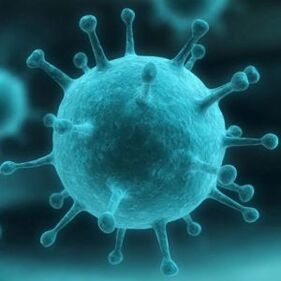
Papilloma is a benign neoplasm of the skin, whose characteristic feature is the base of the connective tissue papilla covered with epithelium at the top. Papillomas occur in humans in various parts of the body (on the skin, mucous membranes, in internal organs and other localizations) and in most animals.
Papillomas develop from transitional or squamous epithelium in the form of soft dense formations on the so-called stalk. The size of these formations usually ranges from 1 to 2 centimeters in diameter, and their outer surface has a white or dirty brown hue. Sometimes papillomas grow in different directions and become like cauliflower or rooster combs.
Papillomas are removed for cosmetic effect if they appear on visible parts of the body - neck, arms, face, however, if they appear on many areas of the mucosa, for example, on the larynx, they can cause life-threatening patency disorders. In the case of the larynx, the papilloma can clog the airways, causing voice problems or the inability to breathe normally, in the case of the bladder, the papillomas cause hematuria. If more papillomas form on the body, it indicates the appearance of papillomatosis.
Etiology of papilloma
The appearance of papillomas is mainly provoked by a viral infection - human papilloma virus (HPV), although sometimes papillomas can occur congenitally or as a complication of inflammatory diseases.When HPV enters the human body, its activity usually begins to manifest after a long time. Often, some provoking factors contribute to the activation of the papilloma virus, due to which soft neoplasms begin to appear on the skin or mucous membranes. The main factors that cause papillomas, experts include stress, reduced immunity, weakening of the body due to treatment, lack of vitamins in the body, skin injuries.
Basically, people are infected with the papilloma virus sexually, however, cases of domestic infection are possible even with very low immunity or in the presence of damaged areas of skin on the body that can come in contact with the HPV carrier. The appearance of papillomas indicates the activation of the existing virus, which is equally possible for both women and men. A baby can become infected with this virus as it passes through the birth canal of an infected mother.

Classification of HPV manifestations
Human papilloma virus that infects the mucous membranes and skin can be classified into the following forms:
- clinical form that can be detected during routine examination: genital, papular and papillary warts, exophytic warts, as well as cervicitis and cervical erosion in women;
- subclinical form, in which the formations have no symptoms, are not visible and can be detected only during endoscopy: inverted formations (growing towards the inside of the mucosa), flat warts, as well as warts in the cervical canal;
- latent form, characterized by the absence of a clinic and detected exclusively by the results of analyzes;
- female form or cervical form, expressed by cervical cancer or dysplasia of various stages.
When women are infected with highly oncogenic HPV as a result of sexual contact, the likelihood of malignant neoplasms in the cervical canal increases dramatically. When infected with other types of the virus, the likelihood of oncology is not so great, however, a cancerous tumor can appear in the rectum or mouth. In men, the likelihood of cancer due to HPV exists in the anus, penis and rectum.
Types and forms of papillomas
It is very important to correctly identify papillomas that appear on the body. Their types are directly dependent on the strain of the resulting virus which, entering the human body, contributes to the process of excessive cell division in the skin, resulting in papillomas.
HPV strains can be oncogenic and non-oncogenic. There are many more non-oncogenic varieties and they generally do not bring the patient anything but external aesthetic discomfort.
Such a manifestation can be easily removed and thus solve the problem. However, if neoplasms appear in the area of the mucosa, it indicates serious pathological processes. Such dislocation means that the person has become infected with the oncogenic strain of HPV, so complex antiviral therapy is extremely necessary. To distinguish different types of papillomas, it is sufficient to simply compare them with each other and identify the characteristic features of one or another subspecies.

Simple nipples
Simple papillomas or warts are the most common type of papilloma virus that causes several strains at once. These strains of HPV are transmitted not only sexually, but also through contact and daily life, leading to statistics indicating that 30% of the world’s population has encountered such HPV at least once in their lives.
Simple papillomas or vulgar (common) warts are more often localized in other places on the upper extremities, ie on the hands, but can sometimes occur on the body, soles and feet, palms, fingers. Their peculiarity is that such warts appear in places with damaged skin due to a decrease in local immunity. Such papillomas occur in the area of the soles of the feet or palms due to contact with low-quality household chemicals, profuse sweating, various skin damage, and dermatitis.
A vulgar wart looks like a papillary neoplasm on the skin a few millimeters in diameter at the beginning of the disease. In this case, the head of the nipple has a homogeneous and soft texture and rises above the surface of the skin. It is poorly pigmented, and its root goes deep into the skin, from where it gets food from the veins. As a result of such a diet, warts gradually grow, until not only their size but also the degree of pigmentation changes. Also, hair often grows in the center of such papillomas, which is a variant of the norm and does not indicate a malignant neoplasm.
Flat papillomas
These skin lesions look like small yellowish flat plaques that rise slightly above the surface of the skin. Their structure is dense, with a deep subcutaneous root, as evidenced by frequent pain when pressing on the nipple or when it is damaged in everyday life. The localization of such papillomas is most often the face and hands. They can sometimes occur in the anus or on the labia majora in women and in the scrotum in men. Due to the active blood supply, they have an active growth trend.
The main feature of flat papillomas is the difficulty in their treatment. After surgical treatment of these neoplasms, the scars and scars usually remain in place.
Genital warts
Genital warts occur in the groin or mucous membrane area. On the outside, these are thin papillary neoplasms 2-3 millimeters in diameter. Such condylomata grow rapidly, forming a large skin growth from a small single papilla, resembling a cauliflower or rooster.
The main danger of genital warts is the high risk of infection, inflammation of the neoplasms in the vagina or small lips in women. They can be easily injured, after which the infection penetrates the body at high speed. Also, a big problem related to genital warts is the high risk of recurrence, which is not reduced even with the use of antiviral treatment and removal of neoplasms. Several strains of the virus can cause genital warts, some of which can be dangerous for women in terms of the malignant process.

Philip papillomas
Threaded papillomas with a thin stem whose tip is crowned with the head of the neoplasm. It is very difficult to confuse them with other species because of their special appearance, so, looking at a photo of filamentous papillomas, they can be distinguished from other varieties.
Such neoplasms most often occur after the age of 45 in areas where thin skin predominates - on the chest, armpits, neck. Increasing the size of such neoplasms represents their further elongation. The head of filamentous papillomas is usually yellowish or pink, the pigmentation is indistinct, usually very weak.
Internal stains
The subgroup of internal moles includes all neoplasms on the surface of human internal organs. These are intragastric condylomata, papillomas in the rectum, neoplasms in the throat and mouth, neoplasms on the walls of the bladder. A characteristic feature of these papillomas is the impossibility of recognizing them without performing appropriate medical procedures and diagnostics. However, the disease can be suspected by special symptoms. The danger of such neoplasms is identified in each case.
If there are papillomas in the bladder, bleeding or cancer may develop over time.
If the papilloma is located in the larynx, then it helps to block breathing and interferes with a person's speech function.
Lewandowski-Lutz papillomas
Wart epidermodysplasia or Lewandowski-Lutz papillomas are a very rare pathology that mainly affects only children or adolescents. It happens that such a disease can be inherited and spread in the family.
The clinical picture of the disease is manifested in the form of numerous reddish-brown freckled warts in the area of the feet and hands. The characteristic of the pathology is the fact that, when papillomas are located on parts of the body that are exposed to ultraviolet radiation, in a third of all cases they regenerate into malignant neoplasms and grow into the area of adjacent tissues.

Papilloma locations
Filamentous, vulgar or pointed papillomas, as well as condyloma, are most common in physician practice. The site of localization of fibrous warts is the face, vulgar ones are more often located in the area of the feet or hands, and condyloma is exclusively on the mucosa (head of the penis and urethra in men, in the area of small lips and vagina in women), but it happens that any of these wartsthey may appear in an unusual place for themselves.
In modern conditions it is not difficult to remove such papillomas, however, the danger is the fact that reduced immunity can re-emerge new papillomas, which will lead to more serious health consequences, for example, the subsequent appearance of genital warts is fraught with the development of cervical cancer in women. . Plantar warts are most common on rough soles and toes. Occasionally a thorn may develop on the thumb after severe skin damage to the area.
In general, papillomatosis is a generalized form of pathology, in which neoplasms form throughout the human body. These growths have a characteristic appearance, so, once they have seen the manifestations of the disease, it can no longer be confused with any other disease.
HPV symptoms
The most common symptom of papilloma virus in the human body is the appearance of papillomas on the skin.
Other symptoms directly depend on the location and type of disease. Depending on the above signs, the symptoms of HPV may be as follows:
- Genital warts occur on the mucous membranes of the genitals, mouth, larynx, rectum and on the inner surface of the stomach. Symptoms of the onset of pathology in the genital area are itching and an unpleasant odor. If such symptoms start to bother you, they should not be ignored in any case, because very often the cause of its appearance can be of an oncogenic character.
- Intraductal papillomas in the area of the mammary glands whose signs are redness in the area of the nipples, mild itching and burning. Also, if you press the nipple with such a papilloma, then ichor or green discharge begins to leak from it. The danger of intraductal papilloma is its gradual and possible degeneration into breast cancer.
- Plantar warts are expressed by active blisters in the area of the soles, which cause pain when walking or pressing on them in a sharp form.
- Papillomas in the area of the larynx are not initially expressed in any specific symptomatology, but gradually this pathology leads to a change in a person's voice, a feeling of coma in the throat and damage to respiratory functions. Also, the patient begins to have difficulty swallowing.
- Flat warts in adolescents most often occur in the area of the outer arms and lower part of the face. The symptomatology is very blurred and is most often expressed by a mild, infrequent itching of the neoplasm.

Pathogenesis
In the presence of HPV in the human body, it is usually possible to conclude that the immune system is reduced. Entering the body, viruses begin the process of infection of the basal epithelial layer, making the main bias towards the impact of the area of transition from squamous to epithelial layer. Infected cells can have 2 forms of the virus - episomal (outside the cell chromosomes) of benign nature and introsomal (integrated into the cell genomes) with a malignant nature of parasitism.
The incubation period of papilloma virus can vary from the moment the virus enters the body to the first manifestations of the disease in a period of 14 days to several years. The nature of human papillomavirus infection is usually latent or hidden. At the same time, several types of pathologies can be located in the human body at the same time, and under the influence of certain factors, each of them can suddenly begin to manifest itself through active reproduction. In this case, a stage of the disease occurs at which clinical manifestations begin to be identified.
Very often (up to 90% of all cases of HPV infection) during 6-12 months, the human body only heals from this pathology, however in 10% of the remaining cases the disease can become chronic with a long course, relapses and the possibility of malignancy.
Diagnosis of the disease
Ultrasound for papillomas
Ultrasound examination in the diagnosis of papilloma is not used as the main research method, but as an additional method that confirms the accuracy of the alleged diagnosis. Basically, ultrasound is used to diagnose papillomas in internal organs when it comes to their malignant transformation.
Ultrasound is used among instrumental verification techniques to diagnose intraductal papilloma.
Conducting an ultrasound examination in this case does not allow the specialist to examine the mammary gland channels, however it helps to distinguish intraductal papilloma from suspected breast cancer, which allows the exclusion of galactorrhea in prolactinomas. Also, ultrasound can help detect the appearance of neoplasms with bladder papilloma. However, ultrasound is effective in this case only if the diameter of the neoplasm exceeds 1 centimeter.

PCR diagnostics at diagnosis
The diagnosis of the disease in question is made by doctors, dermatologists and venereologists. Since the number of virus types varies, it is important to determine exactly which type the patient is infected with and whether this strain has an oncogenic character. Visually, it is possible to make an accurate diagnosis only in the case of classic genital warts, which is why, if there is a suspicion of HPV infection, experts always use PCR scraping.
Polymerase Chain Reaction (PCR) invites researchers not only to determine the presence of HPV in the body, but also to demonstrate its type, oncogenicity, and virus number at the time of diagnosis. This is very important diagnostically, because if there is information about the percentage of the virus in the body, it is possible to determine the approximate time of infection and establish contact with the patient's person to conduct etiotropic therapy.
Based on the results of PCR diagnostics, it is possible to determine the chronic course of the infection or its one-time exit due to reduced immunity. This information provides the specialist with the opportunity to prescribe therapy appropriate to the particular case. Usually PCR diagnostics is performed in the form of screening. If the presence of the virus in the body is confirmed, the patient continues to be examined by other techniques.
HPV biopsy
Biopsy in medicine refers to the process of taking samples of human tissue for their subsequent examination by staining with special dyes. Biopsy is very common for cancer as well as for suspected HPV. On the eve of treatment of papilloma virus, doctors must rule out the oncological nature of the tumor.
Biopsy is a very precise diagnostic technique that, if HPV is suspected, can be expressed in cytological or histological studies.
A cytological examination is an examination of body cells under a microscope, designed to show experts the changes caused by a viral infection in these cells. For the prevention and early detection of cervical cancer, cells for cytological examination of a woman are taken from this organ. If oncogenic types of HPV are detected in women, even in the absence of external manifestations and signs, they are assigned cytological studies every year, which allows them to see the signs of cervical dysplasia in a timely manner. The fact is that dysplasia of this organ is completely curable, and if you do not start the development of the process, then cervical cancer in the body will not develop at all, even with the oncogenic type of virus.
In order to accurately diagnose HPV, a histological study is performed, for which the patient is not taken for analysis by surface scraping of cells, but by a piece of tissue, which allows examination of the correct location of cell layers, tissue characteristics and oncological characteristics. During histological examination with the help of solutions, the tissue sample taken is dehydrated and embedded in paraffin, after which cross-sections are made using microtoms that allow to obtain layers with a thickness of 0. 1 millimeters. The removed layers were stained with special dyes in order to detect pathological cells during microscopic examination and determine their nature.

Treatment of papillomatosis
Treatment of papilloma virus is always carried out according to an individual scheme. If the virus is detected during the diagnosis, but there are no manifestations yet, the patient is prescribed etiotropic cytostatic therapy, which effectively "sleeps" the virus for several years.
If a person is a carrier of HPV, then they should undergo regular PCR diagnostics to identify the initial signs of disease development. In addition, the carrier of this virus is obliged to use barrier contraception in order not to infect sexual partners.
When detecting papilloma virus, the use of antiviral drugs is mandatory. In general, immunomodulatory and vitamin preparations are indicated for absolutely all HPV patients.
When papillomas appear on the mucosa or skin, depending on the location and symptoms, cryodestruction, electrocoagulation and laser removal of growths are resorted to. Sometimes papillomas are removed with a more modern technique - using radio waves. In case of signs of papilloma malignancy, it is surgically excised along with the surrounding healthy tissues around the growth. It is also important to know that papilloma removal does not lead to a complete cure because the virus remains in the body and can recur.
In modern medicine, there are no drugs to completely remove this virus from the body, therefore, when such a diagnosis is detected, even in the absence of manifestations, a person must undergo regular examinations to detect the development of pathology.
Since the papilloma virus is most often sexually transmitted, it is worth giving preference to the barrier method of contraception, and if a woman is planning a pregnancy, it is important to take timely diagnostic measures and take therapy that will reduce the likelihood of contracting the virus.
Disease prevention
The appearance of papillomas on the body can be prevented by respecting the basic rules of personal hygiene and timely disinfection of any wounds. In everyday life, it is necessary to use a separate towel, comb, manicure devices, shoes for each family member, and intermittent sex should always be protected with condoms. It is also important after intercourse to always take a shower and treat the contact areas of the skin and mucous membranes, as it takes some time for the virus to enter the human body.
There is also a vaccine against papilloma virus in modern medicine. Already tested in 72 countries around the world, it is effective against 16 and 18 HPV subtypes that cause cervical cancer in 90% of all diagnosed cases. Also, vaccination successfully fights viruses of subtypes 6 and 11, which cause the development of genital warts, which are difficult to treat. Due to the sexual route of infection with these viruses, vaccination is recommended before a person begins sexual activity. Most often, experts recommend the use of the vaccine three times for girls aged 11 to 12. The World Health Organization also recommends vaccinating a boy to prevent the possibility of HPV circulation.
Are papillomas dangerous?
Papilloma virus is a risk factor for the development of oncological pathologies. The most common cause of this virus is cervical cancer, cancer of the external genitalia (vulva, glans penis). However, HPV infection does not always lead to cancer. There are many subtypes of this virus with a low oncogenic index, for example, subtypes 6, 11, 42, 43, 44, which form warts, but there are also highly oncogenic subtypes - 16, 18, 31, 33, which cause flat warts. From the moment the virus enters the body to the transformation of the tumor into malignant, it can take 10 to 20 years.
If there are large papillomas on the body, which can be very easily damaged in everyday life, they must be removed.
If the papilloma virus that is detected in the body is not treated, then the risk of infection with other infections increases dramatically. And during parallel infectious processes, papillomas begin to appear in other parts of the body, weakening the immune system. It turns out it's a vicious circle. In addition, if some papillomas are not removed, they can degenerate into oncological neoplasms, which means that this disease must be approached with great seriousness and never allow the course of the disease to continue.























